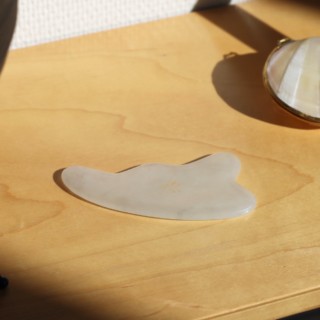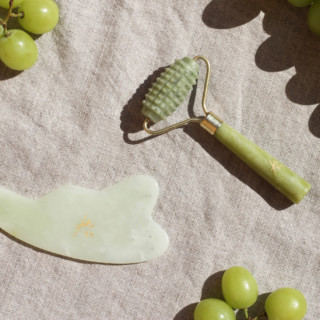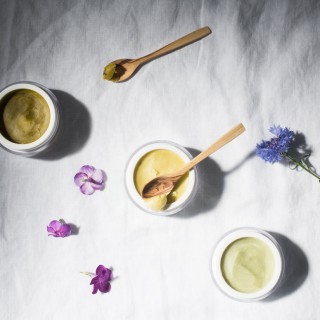This post is a collaboration with Biodelly.fi
As you might recall, I made a post a few months ago, calling for a subject with no prior experience of natural cosmetics, to participate in a skin care study on atopic skin. A candidate was found, and a fairly juicy one at that; the past two months have not gone quite as I had planned, as far as the study is concerned.
Our test subject is Mariko, who has suffered from atopic eczema and extremely sensitive skin ever since she was a baby. Mariko has used cortisone creams and unscented pharmaceutical cosmetics to treat her skin – exactly what I had hoped for. Her skin is extremely sensitive to changes in her environment and the climate, to new products, stress, and the alignment of the stars. To pretty much everything, in other words.
When we photographed her at the start of the experiment, Mariko’s skin was very dry and rough, the eyelids were bumpy, as were her lips and the skin under her nose. Her skin was constantly itching, and the cracked places were oozing fluid. Actually, her skin was in fairly good shape when these photographs were taken, at least compared to a few days later, when her forehead, down to her neck and shoulders , were suddenly covered in eczema, and the sores were oozing even more than previously. The situation was brought on by a change in the products she was using, but also by going from Thailand’s tropical and damp climate, where she’d been vacationing, to the dry and windy climate that greeted her in Finland, as well as by the hot yoga classes Mariko instructs. I had also forbidden her to use pharmaceutical cosmetics, and cortisone cream was only allowed under duress.
Our original plan had been to only use products from the French company, Nafha, but within a few days it became evident that Nafha’s moisturizers and cleansing milk wouldn’t work for Mariko, an her skin was visibly irritated by them. The pure argan and prickly pear oils, eye cream, and body lotion didn’t give us any trouble, so we kept them.
I had to look for new products to use in our study. I chose Sophyto’s cleansing cream, as atopic skin requires as gentle, mild, and surfactant-free cleansing products as possible. Surfactants damage the protective hydrolipidic film of the skin, which is almost non-existent in atopic skin, to begin with. Sophyto’s cleansing cream turned out to be perfect, causing an instant positive reaction in Mariko’s skin.
As I have had several good experiences with using her products on atopic skin, I chose Mia Höytö’s Säihke as a toner. The birch sap and hyaluronic acid used in Säihke make it very hydrating; beta-glucan soothes and protects the skin, while improving its resistance. Mariko’s skin was very dehydrated, tight, and rough, and she had never used a toner before; her skin fell in love with Säihke. I also went for Mia Höytö’s serum, and gave Mariko a twice-a-day skin care regimen which included slathering on Säihke, followed by the Lumous serum, applied onto her face and neck. This would bind moisture and smooth out the skin, making it soft and receptive to further skin care products. Creams used to clog-up Mariko’s skin, purely because it was so dehydrated. Lumous is very high in hyaluronic acid, which is an excellent humectant – or hydrating and moisture-binding ingredient, helping to keep the skin cells plump and hydrated. Lumous also contains lots of birch sap, vitamin C –rich sea-buckthorn to stimulate collagen production, as well as protective beta-glucan.
I also instructed Mariko to use an oil, mornings and evenings, after the serum: either the argan or prickly pear oil from Nafha, or the Skin Rescue Oil from The Organic Pharmacy. She was free to choose which one she preferred, as long as it felt good. Mariko chose the Skin Rescue Oil, and I’m not surprised; the oil is full of repairing rose-hip oil, soothing blue chamomile, as well as primrose, tamanu, and chickweed extracts that help to firm and protect the skin, and heal scars.
We employed three different moisturizers and treatments: Unelma from Mia Höytö, which seals in moisture and softens the skin, to be used in the mornings and evenings; the Ultra Dry Skin cream from The Organic Pharmacy, which is a natural alternative to cortisone or oily creams, to be used on the worst eczema areas and cracks; and finally a hemp cream from Flow Kosmetiikka, which we used to treat Mariko’s cracking lips and eyelids. Together with proper hydration, these creams made all the difference to Mariko’s skin, which welcomed them.
Beyond these, we have been using Nahfa’s eye cream and body lotion, both of which have worked wonderfully.
Armed with these products, we began the study, and are now two months into it. When I saw Mariko a couple of weeks ago, her skin was smooth as a baby’s butt, the cracks were no longer leaking fluid, and the redness had been greatly reduced. The internal imbalance in her body and hot yoga instruction still cause irritation and breakouts, but these are things we can’t treat externally.
In the next post, we’ll be seeing photos of the results, as well as hearing Mariko’s thoughts on the products she used – her first foray into natural cosmetics.
By using the code KATJA15, you get a 15% discount on all full priced products at Biodelly until April 6th 2015.
Test products gifted by Mia Höytö Cosmetics, Cosmetique, Suomen Luonnonkosmetiikan Osuustukku, Biodelly, and Flow Kosmetiikka.
Towels Proloque
Photos Katja Kokko






















